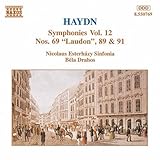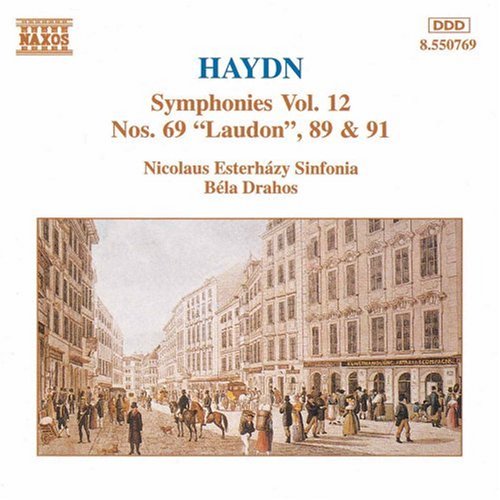Disco de Franz Joseph Haydn: «Haydn: Symphonies Vol. 12, Nos. 69 "Laudon", 89 & 91»

- Valoración de usuarios: (3.7 de 5)
- Título:Haydn: Symphonies Vol. 12, Nos. 69 "Laudon", 89 & 91
- Fecha de publicación:1994-06-28
- Tipo:Audio CD
- Sello discográfico:Naxos
- UPC:730099576925
- 1 Vivaceimg 9:39
- 2Un Poco Adagio Piu Tosto Andante
- 3Menuetto
- 4Finale, Presto
- 5 Vivaceimg 9:39
- 6Andante con moto
- 7Menuet: Allegretto
- 8Vivace Assai
- 9Largo-Allegro Assai
- 10Andante
- 11Menuet: Un poco allegretto
- 12Finale: Vivace
This CD offers a welcome opportunity to hear three of the lesser-known Haydn symphonies -- including two from the years of Haydn's full maturity that produced the "Paris" and the "London" symphonies. The works are performed by the Nicolaus Esterhazy Sinfonia conducted by Bela Drahos as part of a projected complete recording of the Haydn symphonies on the budget-priced Naxos label. The performances are good if not outstanding. The attraction of this CD lies in hearing unfamiliar Haydn. I will begin with the two latter symphonies.
As the reviewer below notes, the sympnony no. 91 in E-flat major is a gem. This symphony dates from 1788-89 and shows a more introspective, lyrical and subtle style than we usually associate with Haydn. The work has the character of a wistful dance. The first movement opens with a slow introduction which Haydn works beautifully into the opening allegro assai. The movement features a gentle legato theme and a dancelike second theme. Both the themes are closely linked with the opening largo. This is a beautifully integrated movement. The second movement, andante, is also highly original. It consists of a set of three variations on a detached, whimsical theme. Listen to the bassoon and the accompanying string filigree in the first variation and the series of trills near the end of the movement. The minuet is flowing and graceful with a dancelike trio in the bassoon accompanied by plucked strings. The finale opens quietly and builds gradually to a strutting and confident close. It is worth contrasting this graceful, lovely work in E-flat major to the broad, heroic works Beethoven wrote in this key, such as the "Eroica" symphony and the "Emperor" concerto.
The symphony no. 89 in F major frequently suffers by comparison with the companion symphony no. 88 in G major, one of Haydn's finest works. But this work has charms of its own and shows much of Haydn's ingenuity as a composer. In this symphony, as stated in the Oxford Composer Companion to Haydn, (p.401) "vigour is tempered by elegance". The first movement, vivace, opens with five stacatto chords followed by a flowing melody. Those familiar with musical structure will notice something highly unusual in this movement. There is no recapitulation per se. After the opening exposition, Haydn proceeds to vary and develop his themes, but he only gets to what would appear to be the development section at the conclusion of the movement. The work, as is so much of Haydn, is full of surprises. With this ingenious movement, we can understand perhaps why Haydn borrowed from an earlier composition in the second and fourth movement of this symphony. Both these movements are taken from a "Concerto for Lira Organizzta" that Haydn composed in 1786, two years before this work, for the King of Naples. The second movement is a siciliene in 6/8 with a flowing theme. The finale starts quickly and includes an unusual musical marking -- strascinado -- which instructs the performers to drag the beginning of the opening theme. This isn't done with much emphasis on the CD. The third movement is a minuet in which the winds have the predominant role. There is a lovely flute solo in the trio.
The final work on this CD is the symphony no. 69 which dates from about 1778. The work is called "Laudon" because Haydn dedicated it to a military hero whose name was acutally Loudon. The work is in C major which, for Haydn, is the key of flash and flamboyance. The opening movement is marked vivace and features a contrast between a marchlike opening with large chords and a softer second theme. There is extensive use of brass. The second movement features the strings in a flowing theme with a darker-hued middle section. The minuet is one of stateliness and pomp where the trumpets return and give a military character to the movement. The finale, vivace assai, opens quietly but soon develops to a vigourous conclusion. Haydn omitted this finale in reduction of this symphony he prepared for the piano. In doing so, he tartly observed to his publisher that the dedication to war hero Laudon was "worth more than ten finales".
This CD will appeal to listeners who love early classical music and who want to hear more of Haydn than the handful of frequently-performed symphonies.
When I first got into classical music, purchasing all 104 symphonies by Haydn seemed like a monumental, if not impossible task. I simply couldn't afford something as grand as the Dorati Complete Haydn Symphonies Boxed Set, and besides I wasn't even sure if I'd like Haydn all that much. I played it safe and made my first four purchases the two Szell Sony Essential Classics discs collecting Symphonies Nos. 92-97 between them, and Bernstein Royal Editions of the Paris (82-87) and London (100-104) Symphonies. (I can't remember why I opted for these instead of the Davis Philips two-fers -- the performances are just as amazing, and they are probably cheaper when all is said and done.)
To say the least, these Szell and Bernstein performances were stunning, and I was definitely on my way to a love affair with Haydn. But as I searched out more single disc Haydn titles, I found it very difficult to fill in the gaps in my collection between Symphonies 80 and 104. I discovered a few quality recordings here and there that fit the bill -- a Furtwangler performance of Symphony No. 88 on DG Originals and a Klemperer recording of Symphony No. 98 on EMI -- but for the most part I came away empty-handed.
At this point, a friend suggested the Naxos label. I was naive then and I told my friend I wasn't interested in hearing Alfred Rumplestiltskin and the East Cowtown Nebraska orchestra perform the great works. He told me not to be such a snob, and assured me that the performances and recording quality were consistently excellent, and that symphonies like the Cologne Chamber Orchestra and the Nicolaus Esterhazy Sinfonia, while not the Berlin Philharmonic, were certainly first class groups.
Well, now I am the proud owner of several Haydn Naxos Symphony CDs, including Volumes 12 (this title), 13, 16, 18, 20 and 21. All the performances are brilliant, and often indistinguishable from the Szell and Bernstein accounts, well at least to my intermediate-level listening ear. At this rate, I may continue backwards with Haydn's Symphonies on Naxos until I reach el numero uno. And another nice thing is that with Naxos that might even be an affordable undertaking.
In my humble opinion, the 91st symphony of Haydn is highly underrated. The slow movement is extremely simple but incredibly beautiful. Unfortunately, the performance here lacks both energy and passion. The 69th and 89th receive better performances, but because of the weak performance of the 91st, I would avoid this recording.

